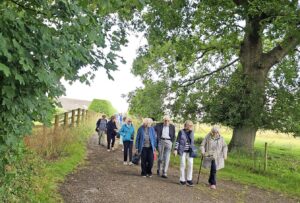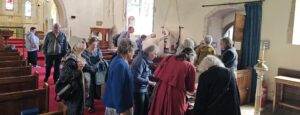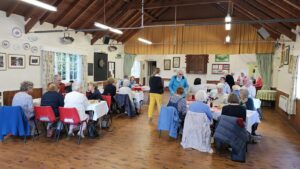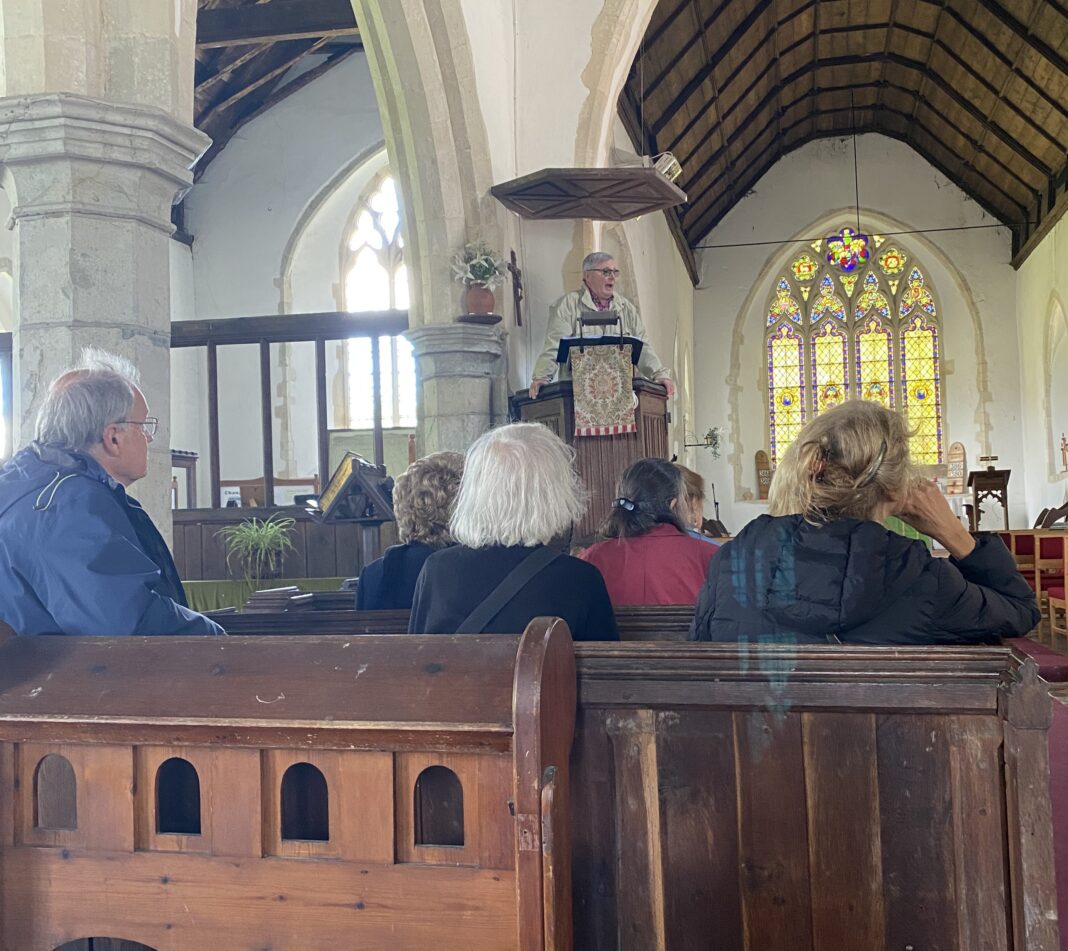Each summer, the Friends of St Mary’s Rye arrange to visit two or three churches on or around Romney Marsh and then take tea with the ladies in Stone.
This year on July 6, there was a variable weather forecast with the prospect of winds and showers. However as the party met the community buses at Station Approach, the clouds shifted and the sun shone.
25 Friends set off across the Marsh to the first stop at one of the oldest of Marsh churches: St Peter and Paul at Bilsington. This is an ancient settlement, dating from Saxon times as it is recorded as Bilsvitone in the Domesday Book 1086. Part of the site is moated, perhaps against Danish invaders in the late dark ages.
 After the Norman Conquest, William allocated the land to his half-brother Odo, Bishop of Bayeux and newly installed Earl of Kent.
After the Norman Conquest, William allocated the land to his half-brother Odo, Bishop of Bayeux and newly installed Earl of Kent.
The Norman church was built in the 1200s, probably replacing a Saxon predecessor. In 1253 a priory of Austin Canons was built next to the church. After change in the medieval period, it was all ceded to the son of Simon de Montfort, but eventually adversely impacted by Henry VIII’s dissolution of the monasteries in 1536.
Next to the church, an ancient manor farmhouse stands within the remains of the moat. This was reputed to be one of the hiding places for the local Aldington Gang in the 1820s.
In 1825 Sir William Cosway purchased the priory estate but came to grief in a carriage accident in London on June 10 1834. His family built an obelisk 52ft high near to the church, which was struck by lightning in 1967 and has recently been restored to its former glory. It provides a landmark to be seen for miles around.
Bilsington church is approached through a farmyard and via a hedge lined track. It is sited on high ground which falls away to the Marsh.
Inside there are plenty of interesting features: windows from 1300 and 1400s, signs of the pre-Reformation removed rood screen, a medieval sedilia and piscina.
After decline in the 1600s the Victorians in the 1880s carried out renovations. One result is that the east windows are somewhat shorter than if they had been original thirteenth century work. There is a fine Royal Arms of 1774 and a lovely reredos. On the west wall there are 150-year-old text boards.
The organ is 20th century and came from Shoreham and a piano reputedly played by Noel Coward, who lived nearby.
After Bilsington it was on to Newchurch, which lies the centre of the Marsh, surrounded by farmland. Newchurch was mentioned in the Domesday Book as the name of a hundred, which suggests that there was a Saxon church here at the Norman Conquest (1066).
In 1799 it was described as a ” parish in flat marsh grounds, with hardly a tree or hedge among them. The village consists of only a few straggling houses near the church.”

The main extant parts of the church were built in the 13th and 14th century, although a church existed here at least as early as the 11th century. The nave is 14th century, but the chancel survives from the first half of the 13th century, as does the chancel arch and the arches to the north and south chapels from the chancel. The aisles and chapels are from the 14th century, so rebuilding must have been undertaken at some stage.
The first two stages of the tower were built in the late 14th or early 15th century, but subsidence led to the tower leaning over to the west, and needing buttresses to prevent further movement. When the third stage was added it was built vertically, thereby giving the tower its characteristic ‘bent’ appearance.
There is an octagonal font, dating from the 15th century. The bowl is decorated with shields and roses. Cross keys represent St Peter, and a sword, St Paul.
In the north chapel, there is an interesting display, researched and presented by local residents, including information panels and a collection of agricultural implements formerly used around the village.
There is a piscina and former aumbry on the south wall of the chapel, with a statue of Madonna and Child in the piscina.
After Newchurch, the final stop was St Mary in the Marsh, which is a picturesque mid 12th century church set upon a mound above the one-time level of winter flooding.
As with so many Marsh churches, the aisles were added in the 13th century to accommodate an increasing number of guild and chantry altars, leaving the nave free for an increasing congregation.
Outside, in the south wall of the chancel, a priest’s door remains and next to it a scratch dial can be seen. In the churchyard, simple wooden posts and a rail mark the grave of E Nesbit, author of The Railway Children and other children’s books.

After St Mary in the Marsh it was on to Stone and a tea provided by the Ladies of Stone (formerly Women’s Institute) in their memorial hall. Tea here has become a tradition for the friends as the tea served on WI china is renowned.
Before heading back to Rye in an early evening glow, the chair thanked the Stone ladies, the community transport, Gill and Paddy Harvey who helped administer the event and all those who attended. Planning for the 2025 event is already under way.
Image Credits: Anthony Kimber .



